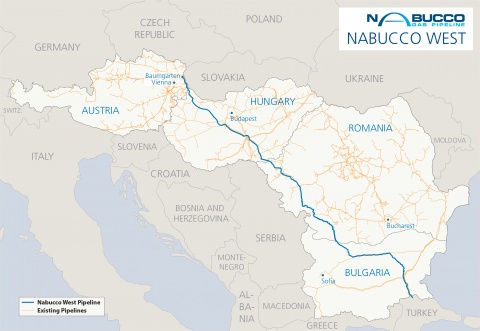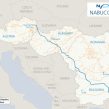
Nabucco-West Selected for Caspian Gas Delivery to Central Europe
Publication: Eurasia Daily Monitor Volume: 9 Issue: 124
By:

On June 28, the Shah Deniz gas producers’ consortium in Azerbaijan announced that it has selected the Nabucco-West pipeline project to be the route for Caspian gas into Central Europe. This decision is an immediate consequence of the Azerbaijan-Turkey inter-governmental agreement, signed on June 26, to build a Trans-Anatolia pipeline (TANAP) for Caspian gas to Europe (see EDM, June 27, 29).
Planned to run from Bulgaria to Vienna, Nabucco-West itself is a direct consequence of the game-changing TANAP project. The Trans-Anatolia line necessitates a continuation route into Europe to deliver Caspian gas. The Shah Deniz producers’ selection of Nabucco-West follows logically from Baku’s and Ankara’s decision to build the Trans-Anatolia pipeline with scalable capacity for potentially large volumes of Caspian gas. Nabucco-West proposes to handle such volumes. By contrast, Nabucco’s rival pipeline projects envisaged comparatively small volumes. The one remaining competitor, Trans-Adriatic Pipeline (TAP) would divert the Caspian gas flow from Central Europe toward Italy.
Nabucco-West is the shortened version of the decade-old, unbankable Nabucco pipeline project, which was to have run from Turkey’s eastern border to Vienna. The shortened version eliminates the long stretch via Turkey. It would, instead, run from Bulgaria to Vienna, thereby drastically reducing Nabucco’s construction costs. In effect, TANAP replaces the Nabucco project across Turkey’s territory, with Azerbaijan and other shareholders covering the construction costs there.
The reconfigured Nabucco would run from the Turkish-Bulgarian border to the Baumgarten continental gas hub near Vienna – a distance of 1,300 kilometers, instead of 3,900 km of the old Nabucco from Turkey’s east (a distance that, with other factors, ultimately killed the old Nabucco). Nabucco-West envisages a diameter of 1,200 millimeters (48 inches) along the route, and an initial capacity of 10 billion cubic meters (bcm) annually, scalable to 23 bcm annually in the second stage, contingent on additional Caspian volumes. Azerbaijan and the EU Commission anticipate and work toward obtaining those volumes in both Azerbaijan and Turkmenistan (Trend, 1News.Az, Dow Jones, June 28, 29; see EDM, June 28).
Nabucco-West is the optimal continuation route from the Trans-Anatolia line into EU territory (see below). Relieved of its Turkish stretch (nearly two thirds of the old Nabucco’s length), the prohibitively expensive Nabucco becomes bankable as Nabucco-West, and can make a cost-effectiveness-based case to investors. The old Nabucco project was practically dead in late 2011, but the project’s strategic rationale was valid – and the need for such a pipeline in Europe, imperative.
Azerbaijan’s initiative with Turkey to launch the Trans-Anatolia project, far from “killing” Nabucco, actually rescued it for this new role. When Azerbaijan and Turkey signed the inter-governmental memorandum of understanding on TANAP (December 26, 2011), the Nabucco consortium responded by working out a reconfigured version of its project as Nabucco-West.
With the Trans-Anatolia line running from the Georgian-Turkish border to the Turkish-EU border, Nabucco-West would transport the gas into EU territory, from the Turkish-Bulgarian border to the Baumgarten hub near Vienna (which also connects with Germany’s pipeline network). The Nabucco-West project is configured for strategically significant gas volumes. This is certainly a motivation for Azerbaijan and possibly for other Shah Deniz consortium partners also, but not for all of them.
According to their June 28 communique, Shah Deniz producers selected Nabucco-West owing to its “greater maturity”, compared with other transportation options. The Shah Deniz consortium will work with the Nabucco project company to optimize the latter’s commercial offer (i.e., tariff-related issues) and technical preparations. Meanwhile, Shah Deniz producers will also “work with” the Trans-Adriatic Pipeline project; and will ultimately select either TAP to Italy or Nabucco-West to Central Europe by mid-2013 (Shah Deniz consortium press release, June 28).
In acknowledging Nabucco-West’s “greater maturity,” the Shah Deniz consortium alludes to the legal and technical base, inherited from the old Nabucco. That inheritance includes the inter-governmental agreement, the project-support agreements in each participant country, a host of permits and authorizations along the route, and initial project-engineering work. By these maturity criteria, TAP would be far from qualifying at present. For all its trans-Adriatic title, TAP is a long trans-Balkan route with a short trans-Adriatic segment. TAP’s long east-west section across Greece lacks the legal-contractual basis and permitting arrangements that Nabucco has already secured on its route.
Among the Shah Deniz gas producers, Norway’s Statoil is concurrently the lead partner in the TAP project. Statoil campaigns for TAP within the Shah Deniz consortium and at the EU in Brussels (although TAP ownership is 85 percent non-EU). The other Shah Deniz producers have no vested interest in TAP. Nevertheless, orchestrating a competitive race during the next twelve months between Nabucco and TAP makes eminent business sense for the gas producers. It enables them to assess the two commercial offers on a comparative basis and bargain down the tariffs on either pipeline project, ahead of the Shah Deniz final investment decision due in mid-2013.
Strategically, however, only Nabucco meets the EU’s supply diversification goals. Italy’s gas supplies are ample and highly diversified already, even if an Italian winter is dramatically portrayed as Arctic-like to justify TAP taking the 10 bcm of Shah Deniz Phase Two gas to Italy (European Energy Review, May 31). Conversely, Nabucco-West is configured for strategic volumes to target the Nabucco participant countries. According to EU Energy Commissioner Guenther Oettinger, “It is clear that Vienna [Baumgarten] is the European hub in the gas business. For this reason, we want the gas to come to Austria from the Caspian region through Bulgaria, Romania and Hungary” (Der Standard, June 22).
German RWE (in the Nabucco consortium) and BayernGas (outside the consortium) also count on gas volumes through Nabucco-West via Baumgarten. The State Oil Company of Azerbaijan is also clearly interested in reaching the Baumgarten hub.




